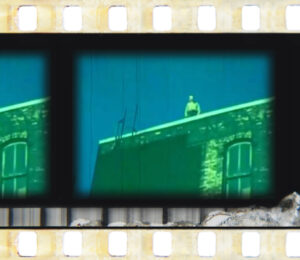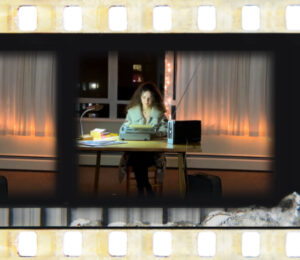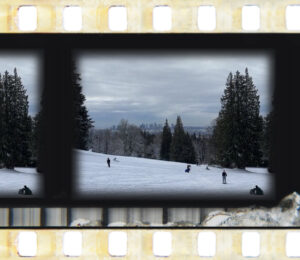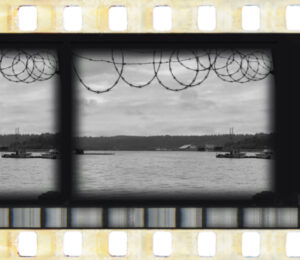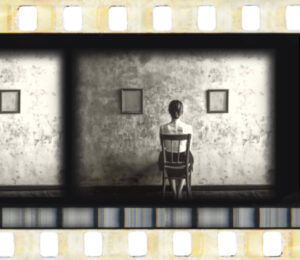
In this quietly humorous and emotionally layered short, a shy Japanese newcomer in Vancouver places all her faith in an unusual superstition: the belief that rubbing her leg brings good luck. Framed through the lens of a cheerful social media vlogger, Lucky Leg begins as a casual interview but slowly drifts into something more tender, strange, and quietly transformative.
Shot in lo-fi black and white the observational style film explores themes of migration, perception, and understated power. As Hina prepares for a job interview, with her documentarian in tow, her calm conviction gently reframes the skepticism around her.
With minimal exposition and a gentle resistance to stereotype, Lucky Leg explores migration, isolation, and self-belief, not through spectacle, but through someone who doesn’t need to be explained to be understood.
I’m Flying
Found Footage – Experimental – 5m 26s
I’m Flying is a lyrical and deeply intimate short film that explores a profound emotional bond between two men, unfolding through a collection of personal emails. At its heart, the film is a meditation on platonic love, vulnerability, and the emotional depth of male friendship. These are relationships that are rarely portrayed with such candor and complexity on screen.
Through a poetic blend of 1960s Super 8 cine film and found footage, I’m Flying evokes a powerful sense of nostalgia and memory. The imagery, grainy, flickering, and fragile, mirrors the elusive nature of the past and honors the visual language of home movies from a time when capturing personal moments on film was an act of quiet preservation. These visuals serve both as emotional resonators and as a metaphor for the fragmented, nonlinear way memories of love and loss often return.
The film is shaped by a one-way correspondence: a series of raw, introspective emails from a man named Mike, written in moments of longing, reflection, and emotional struggle. His words, candid and unfiltered, trace a journey through addiction, mental illness, and solitude, but also reveal a deep, sustaining affection for the person he is writing to. The intimacy of his letters echoes the emotional core of The Sorrows of Young Werther, Goethe’s classic epistolary novel, where written words serve as lifelines and confessions.
Influenced by works such as Patrick Keiller’s London, Kelly Reichardt’s Old Joy, Kim Ki-duk’s Spring, Summer, Fall, Winter… and Spring, and Call Me by Your Name by Luca Guadagnino, I’m Flying joins a cinematic tradition that gently probes the boundaries of male intimacy. It examines those elusive spaces where love exists without clear labels, where emotional closeness can carry the weight of romantic connection, yet remain undefined.
The story also gestures toward lived experience, of friendship forged in a foreign city, of navigating both bureaucratic systems and nightlife, of late-night conversations, shared joys, and personal darknesses. Through Mike’s voice, a world is quietly rebuilt, not one of linear narrative or dramatic events, but one of emotional resonance, where moments of comfort, desire, and pain sit side by side.
I’m Flying is not a film about resolution or transformation. It is an elegy for a friendship that defied convention, a cinematic portrait of a man expressing his truth through words, and the invisible thread that connects two people across distance, time, and silence. In celebrating emotional honesty and the beauty of male vulnerability, the film offers a rare and poignant look into the connections that shape us, sustain us, and sometimes quietly save us.
We’re all just passing through
Found Footage – Experimental – 4m 47s
We’re All Just Passing Through is a haunting meditation on the meaning of home, composed entirely from meticulously sourced and carefully matched archival footage paired with a new narrative voice. This short film reframes forgotten North American imagery to evoke deeply personal yet universally resonant emotional terrain. Trains cut across vast landscapes. Families gather in moments both tender and tense. Layered with analogue hiss and crackle, the sound design conjures a warm, imperfect past that exists outside of time.
Rather than mining personal recordings, the film explores home as something broader, something elusive. It reflects the experience of someone who once had a loving family home but later had to reconstruct that idea entirely when traveling alone through unfamiliar places. In the absence of literal documentation, archival fragments become vessels for memory and emotion, carrying within them all the contradictions of what home can be, comfort and loss, transition and belonging, silence and noise.
The narrative unfolds through a carefully crafted voice that feels like an audio diary uncovered decades after it was recorded, one that refuses to anchor itself to any one identity. Instead, it speaks on behalf of anyone who has ever built a home, lost one, or carried it within themselves like a secret.
At its core, the film is about searching. The editing process mirrors this, finding rhythm not in plot but in feeling. The footage is carefully curated, sometimes sampled from controversial events, sometimes from mundane family memories to elicit moments of recognition. A mother’s kiss. A sibling’s glance. A child shrinking from a camera’s gaze. These gestures, though belonging to strangers, feel familiar. Their emotional clarity transcends context.
By the end, the film doesn’t offer a fixed definition of home. Instead, it leaves behind an atmosphere a lingering sense that home is not a destination but a condition. It can be fragile. It can be rebuilt. And sometimes, it exists only in transit.
We’re All Just Passing Through is a quietly powerful work of memory and imagination, where the past is not merely preserved but reanimated, and where stories not lived firsthand can still speak to the essence of our shared human condition.
Letters Home
Live action – Found Footage – 10m 49s
Isabella, a twenty-something Brazilian woman, has recently emigrated to Canada to pursue her university studies. Living alone in a small, modest bedsit near campus, she navigates the challenges of her new life far from the comforts of home. Each evening, after her classes, Isabella sits at an old typewriter, a cherished gift from her mother, Iris, and writes letters home.
In her letters, Isabella reflects on the stark contrasts between the vibrant, familiar countryside of Brazil and the cold, expansive landscapes of Canada. She writes of her newfound independence, her moments of loneliness, and the strength she is discovering in herself as she adapts to life abroad.
Meanwhile, Iris writes back from Brazil, her letters filled with both practical motherly advice and the aching vulnerability of a woman coping with her daughter’s absence. Having recently lost her own mother, Iris faces the dual weight of grief and the bittersweet pride of seeing Isabella become the first in their family to attend university and travel abroad.
As Christmas approaches, the distance feels heavier for both women. For Isabella, it is the first holiday spent away from her family, a painful reminder of the sacrifices made in pursuit of her dreams. For Iris, the season underscores the changes in their family’s dynamic, marking a poignant shift as her daughter steps fully into adulthood.


